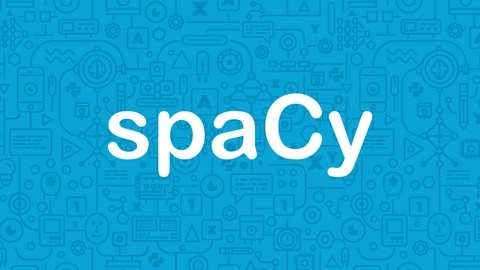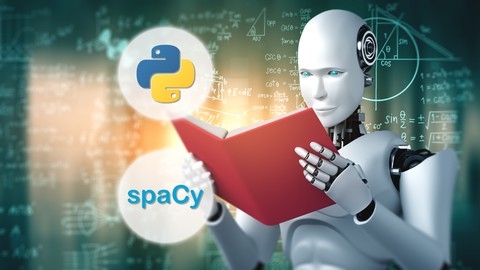Natural language processing (NLP) is a field of computer science that focuses on enabling computers to understand and process human language.
It’s a rapidly growing field with applications in various industries, including data analysis, text mining, and machine learning.
Spacy is a popular open-source library for NLP in Python that provides efficient tools for text processing and analysis.
It’s widely used for tasks like tokenization, part-of-speech tagging, named entity recognition, and dependency parsing.
Finding a good Spacy course on Udemy can be challenging.
With so many options available, it can be hard to know which one is right for you.
You’re looking for a course that’s comprehensive, engaging, and taught by experts, but also fits your learning style and goals.
We recommend Natural Language Processing (NLP) in Python with 8 Projects as the best course overall.
This course is highly regarded for its comprehensive coverage of NLP concepts, practical projects, and hands-on experience with Spacy.
You’ll learn everything from the basics of NLP to advanced techniques like deep learning and text generation.
This course will equip you with the skills to tackle real-world NLP problems and develop your own intelligent applications.
While this is our top pick, there are other great Spacy courses available on Udemy.
Keep reading to discover our full list of recommendations, tailored to different learning levels and goals, to find the perfect course for your journey into the exciting world of NLP.
Natural Language Processing (NLP) in Python with 8 Projects
This course covers a wide range of topics, from the basics of NLP to advanced techniques like deep learning and text generation.
You’ll start by learning the fundamentals, such as tokenization, stemming, lemmatization, and stop word removal.
These are essential preprocessing steps for working with text data.
The course then dives into more advanced concepts like parts-of-speech tagging, named entity recognition, and sentence segmentation.
Once you have a solid understanding of the basics, you’ll apply what you’ve learned to real-world projects.
The first few projects focus on tasks like spam message classification, restaurant review prediction, and sentiment analysis of IMDB, Amazon, and Yelp reviews.
You’ll get hands-on experience with techniques like bag-of-words models, random forests, support vector machines, and naive Bayes algorithms.
The course then shifts gears to text summarization, where you’ll learn how to automatically extract summaries from documents using techniques like word frequency analysis and sentence scoring.
From there, you’ll delve into the exciting world of deep learning for NLP.
You’ll learn about word embeddings, which are dense vector representations of words that capture semantic relationships.
You’ll train your own embedding models and use pre-trained models like Word2Vec and GloVe.
Next, you’ll explore two powerful deep learning architectures for text classification: convolutional neural networks (CNNs) and recurrent neural networks (RNNs).
You’ll build models to classify spam messages using these techniques.
The course also covers text generation using TensorFlow, Keras, and LSTMs.
You’ll learn how to generate realistic-looking text, which has applications in areas like chatbots and creative writing.
In addition to NLP-specific topics, the course provides a solid foundation in data analysis with NumPy and pandas.
You’ll learn how to work with arrays, DataFrames, handle missing data, and perform operations like grouping, merging, and concatenating data.
Finally, you’ll dive into data visualization with Matplotlib, learning how to create various types of plots and customize their appearance.
Throughout the course, you’ll work on hands-on projects that reinforce the concepts you’ve learned.
2024 Introduction to Spacy for Natural Language Processing
You will start with the basics of NLP and Spacy, covering topics like tokenization, part-of-speech tagging, and dependency parsing visualization.
The course then dives into more advanced concepts such as sentence boundary detection, stop word removal, lemmatization, and stemming.
You will learn how to perform rule-based matching for tokens, phrases, and entities in Spacy.
The course also covers named entity recognition (NER), a crucial technique for extracting named entities like people, organizations, and locations from text.
You will explore word-to-vector representations and sentence similarity calculations using Spacy.
A key focus of the course is resume (CV) parsing using Spacy.
You will learn how to extract relevant information from resumes, such as work experience, education, and skills.
The course provides a detailed introduction to NER training, including data preparation, configuration setup, and training with transformers.
Throughout the course, you will work with code files and practical examples, ensuring you gain hands-on experience with Spacy’s features.
Key concepts like rule-based matching, NER, word frequency analysis, and lemmatization are covered in depth, equipping you with the skills to tackle real-world NLP tasks effectively.
Natural Language Processing For Text Analysis With spaCy
You’ll start by learning the basics of NLP and why it’s important.
The course then dives into setting up your environment with Python and Google Colaboratory, which allows you to run code in the cloud without installing anything locally.
From there, you’ll get hands-on experience with spaCy’s core features like working with Doc objects, text cleaning, language models, stop word removal, and lemmatization.
You’ll learn how to build NLP pipelines and add custom components like token matchers, phrase matchers, and entity rulers for information extraction tasks.
The course also covers more advanced topics like semantic similarity using word vectors, visualizing textual relationships, and working with dependencies between entities.
There are practical case studies too, like mining financial data using part-of-speech tagging and visualizing named entities.
You’ll gain experience with related Python libraries as well, including Pandas for data cleaning and manipulation, NumPy for numerical computing, and data visualization principles.
The course even touches on dimensionality reduction with principal component analysis (PCA).
Throughout the course, you’ll work with real-world examples and get practice applying the concepts you learn.



